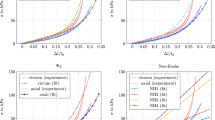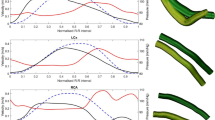Abstract
Physiologically relevant simulations of blood flow require models that allow for wall deformation. Normally a fluid–structure interaction (FSI) approach is used; however, this method relies on several assumptions and patient-specific material parameters that are difficult or impossible to measure in vivo. In order to circumvent the assumptions inherent in FSI models, aortic wall motion was measured with MRI and prescribed directly in a numerical solver. In this way is not only the displacement of the vessel accounted for, but also the interaction with the beating heart and surrounding organs. In order to highlight the effect of wall motion, comparisons with standard rigid wall models was performed in a healthy human aorta. The additional computational cost associated with prescribing the wall motion was low (17%). Standard hemodynamic parameters such as time-averaged wall shear stress and oscillatory shear index seemed largely unaffected by the wall motion, as a consequence of the smoothing effect inherent in time-averaging. Conversely, instantaneous wall shear stress was greatly affected by the wall motion; the wall dynamics seemed to produce a lower wall shear stress magnitude compared to a rigid wall model. In addition, it was found that if wall motion was taken into account the computed flow field agreed better with in vivo measurements. This article shows that it is feasible to include measured subject-specific wall motion into numerical simulations, and that the wall motion greatly affects the flow field. This approach to incorporate measured motion should be considered in future studies of arterial blood flow simulations.








Similar content being viewed by others
References
Assemat, P., and K. Hourigan. Evolution and rupture of vulnerable plaques: a review of mechanical effects. ChronoPhysiol. Ther. 3:23–40, 2013.
Barakat, A. I. Blood flow and arterial endothelial dysfunction: mechanisms and implications. C.R. Phys. 14:479–496, 2013.
Caballero, A., and S. Laín. A review on computational fluid dynamics modelling in human thoracic aorta. Cardiovasc. Eng. Technol. 4(2):103–130, 2013.
Gao, F., Z. Guo, M. Sakamoto, and T. Matsuzawa. Fluid–structure interaction within a layered aortic arch model. J. Biol. Phys. 32:435–454, 2006.
He, X., and D. N. Ku. Pulsatile flow in the human left coronary artery bifurcation: average conditions. J. Biomech. Eng. 118:74–82, 1996.
Heiberg, E., J. Sjogren, M. Ugander, M. Carlsson, H. Engblom, and H. Arheden. Design and validation of segment—freely available software for cardiovascular image analysis. BMC Med. Imaging 10:1, 2010.
Jin, S., J. Oshinski, and D. P. Giddens. Effects of wall motion and compliance on flow patterns in the ascending aorta. J. Biomech. Eng. 125:347–354, 2003.
Khanafer, K., J. Bull, and R. Berguer. Fluid–structure interaction of turbulent pulsatile flow within a flexible wall axisymmetric aortic aneurysm model. Eur. J. Mech. B 28:88–102, 2009.
Ku, D. N., D. P. Giddens, C. K. Zarins, and S. Glagov. Pulsatile flow and atherosclerosis in the human carotid bifurcation. Positive correlation between plaque location and low oscillating shear stress. Arteriosclerosis 5:293–302, 1985.
Lantz, J., J. Renner, and M. Karlsson. Wall shear stress in a subject specific human aorta—influence of fluid–structure interaction. Int. J. Appl. Mech. 3:759–778, 2011.
Malek, A. M., S. L. Alper, and S. Izumo. Hemodynamic shear stress and its role in atherosclerosis. JAMA 282:2035–2042, 1999.
Moireau, P., N. Xiao, M. Astorino, C. A. Figueroa, D. Chapelle, C. A. Taylor, and J. F. Gerbeau. External tissue support and fluid–structure simulation in blood flows. Biomech. Model. Mechanobiol. 11:1–18, 2012.
Mynard, J. P., B. A. Wasserman, and D. A. Steinman. Errors in the estimation of wall shear stress by maximum Doppler velocity. Atherosclerosis 227:259–266, 2013.
Petersson, S., P. Dyverfeldt, and T. Ebbers. Assessment of the accuracy of MRI wall shear stress estimation using numerical simulations. J. Magn. Reson. Imaging 36:128–138, 2012.
Resnick, N., H. Yahav, A. Shay-Salit, M. Shushy, S. Schubert, L. C. M. Zilberman, and E. Wofovitz. Fluid shear stress and the vascular endothelium: for better and for worse. Prog. Biophys. Mol. Biol. 81:177–199, 2003.
Steinman, D. A. Image-based computational fluid dynamics modeling in realistic arterial geometries. Ann. Biomed. Eng. 30:483–497, 2002.
Taylor, C. A., M. T. Draney, J. P. Ku, D. Parker, B. N. Steele, K. Wang, and C. K. Zarins. Predictive medicine: computational techniques in therapeutic decision-making. Comput Aided Surg. 4:231–247, 1999.
Taylor, C. A., and C. Figueroa. Patient-specific modeling of cardiovascular mechanics. Annu. Rev. Biomed. Eng. 11:109–134, 2009.
Taylor, C. A., and D. A. Steinman. Image-based modeling of blood flow and vessel wall dynamics: applications, methods and future directions. Ann. Biomed. Eng. 38:1188–1203, 2010.
Torii, R., J. Keegan, N. B. Wood, A. W. Dowsey, A. D. Hughes, G.-Z. Yang, D. N. Firmin, S. A. Thom, and X. Y. Xu. MR image-based geometric and hemodynamic investigation of the right coronary artery with dynamic vessel motion. Ann. Biomed. Eng. 38:2606–2620, 2010.
Acknowledgments
This study was funded by the Swedish e-Science Research Centre, the Centre for Industrial Information Technology, the Swedish Research Council, and the European Research Council. The Swedish National Infrastructure for Computing is acknowledged for computational resources provided by the National Supercomputer Centre.
Conflict of interest
The authors declared that they have no conflict of interest.
Statement of Animal Studies
No animal studies were carried out by the authors for this article.
Statement of Human studies
All procedures followed were in accordance with the ethical standards of the responsible committee on human experimentation (institutional and national) and with the Helsinki Declaration of 1975, as revised in 2000 (5). Informed consent was obtained from the subject for being included in the study.
Author information
Authors and Affiliations
Corresponding author
Additional information
Associate Editor Ajit P. Yoganathan oversaw the review of this article.
Electronic supplementary material
Below is the link to the electronic supplementary material.
Rights and permissions
About this article
Cite this article
Lantz, J., Dyverfeldt, P. & Ebbers, T. Improving Blood Flow Simulations by Incorporating Measured Subject-Specific Wall Motion. Cardiovasc Eng Tech 5, 261–269 (2014). https://doi.org/10.1007/s13239-014-0187-5
Received:
Accepted:
Published:
Issue Date:
DOI: https://doi.org/10.1007/s13239-014-0187-5




